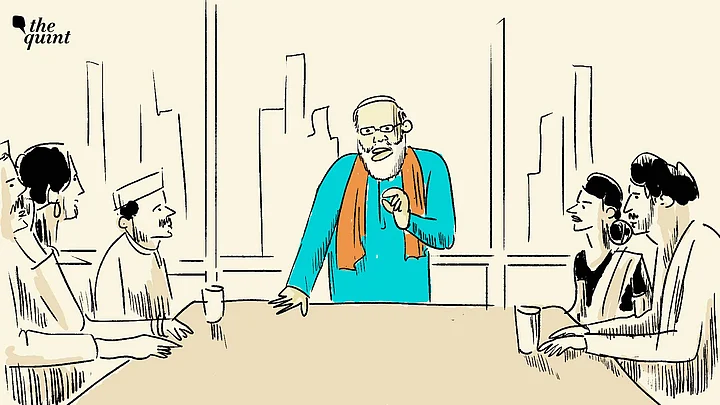As you embark upon reading this article, I urge you to consider Prime Minister Narendra Modi as a CEO of a Navratna company, a large public sector company with comparative advantages.
With this mental image, let’s examine the mega cabinet expansion that grabbed world headlines as the leader chose to sack the country's health minister amid the pandemic and the IT and law minister who—with PM Modi’s blessings—had launched a massive legal battle with social network giants such as Twitter and Facebook.
Prime Minister Narendra Modi, the CEO
The leader, like a CEO, chooses to be dynamic and has shown no hesitation in firing senior colleagues to prove how firm he can be to punish alleged under-performers. And in the process, he deflects attention from questionable decision-making on his part as the boss who owes no explanation to anyone. He does not have to justify the vision behind handing pink slips amidst the ongoing humanitarian crisis.
PM Modi, instead, demonstrates that he is in favour of recapitalisation and consolidation plan for himself, as he aims to claw back to his own political capital; some of it evaporated due to Covid mismanagement and economic policy paralysis.
The slipping vote share of the BJP in state polls threatens further erosion. Modi, like a successful CEO, considers himself as a powerful brand name. He wasn't prepared to witness the kind of criticism he faced when the second Covid surge hit us as domestically and globally his personal image of "can do" took a beating.
This CEO Follows a Pattern
PM Modi's response to this crisis as an agile CEO is at display. While the sacking of 12 ministers is an indirect admission of failure, the cost has been imposed on someone else. By doing so he has not only punished so called non performers but also pushed some of the senior leaders who were not fully beholden to him.
Modi was swift in sidelining LK Advani and many of his contemporaries soon after he became PM in 2014. Ravi Shankar Prasad, Dr Harshvardhan and Prakash Javadekar are among those who grew during Vajpayee-Advani era.
Purely from the union government perspective, the Vajpayee era comes to an end with latest actions. Except Rajnath Singh and Nitin Gadkari, the core team is now mostly of Modi loyalists. During the last term, Suresh Prabhu, Uma Bharati and Maneka Gandhi were ejected.
In the current dispensation after Narendra Singh Tomar and Arjun Munda, Smriti Irani and Piyush Goyal are next in the order of seniority but the latest round of work allocation shows they are stuck. Both have been divested of more important portfolios. Surely, as of now there is no promotion for them.
We have seen the emergence of functionaries like Bhupendra Yadav, Ashwini Vaishnav and Anurag Thakur. The CEO is banking on young blood and their loyalty has already been tried and tested.
Diversify like a CEO, Shed 'High Maintenance Assets'
Many leaders with mass base are not part of his core group.
Exhibit A: Shivraj Singh Chauhan, Yogi Adityanath and Yediyurappa are not part of the core group in political sense even though they are chief ministers.
Exhibit B: Vasundhara Raje and Raman Singh are other names to illustrate the point about how the Modi led BJP is shaping up for next round of consolidation of Modi era.
The model Modi has followed is replace maintenance heavy assets with lighter assets. 'Injecting young blood' is a euphemism for those who would be beholden to him, and him alone. Many of the new choices do have a localised community base. They have done well but they are lighter assets, thus, easy to manage. In contrast, a seasoned and competent Sushil Kumar Modi is kept out and comparatively junior ones, coming from Rajya Sabha route are promoted.
As far as managing politics and elections is concerned, this move is a big step forward. Recapitalise with lighter assets, consolidate with junior, energetic, and subservient functionaries. Most of them are expendable. Like team of rivals calls them team of expendables. No doubt, Modi is a visionary with single-minded focus on building his legacy of the size and scale that we haven't seen before. From that perspective, this consolidation plan is yet another step in that direction.
Will PM Modi's Recapitalisation Plan Bring Him Back in 2024?
Despite a lot of commentary, I have not seen such a big expansion and sacking that is this puzzling. Some Modi government Budgets have been inscrutable for days. This holds true for this reshuffle, too.
The key puzzle is about people and process. The kind of centralised PMO and uni-directional command and control structure we see, will a mere change of people change the ways of governance? For real change the process has to change. As of now, there are no visible signs of change in process.
Will this move help solve India's current problems from vaccine shortage to economic revival to jobs? I quote Local Circles survey done after the expansion. While many welcomed the sacking of non performers, only 4% citizens believe this move will bring better governance. This survey was done among 9618 citizens from 309 districts. 53% people said that to improve governance delivery clear objectives and accountability is needed.
The recapitalisation plan will succeed if governance is delivered. The moot point is who will question the CEO’s decision making for the next three years before the public mandate is due.
(At The Quint, we question everything. Play an active role in shaping our journalism by becoming a member today.)
